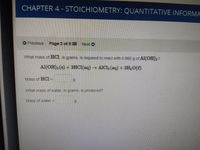
Chemistry
10th Edition
ISBN: 9781305957404
Author: Steven S. Zumdahl, Susan A. Zumdahl, Donald J. DeCoste
Publisher: Cengage Learning
expand_more
expand_more
format_list_bulleted
Concept explainers
Question

Transcribed Image Text:CHAPTER 4 - STOICHIOMETRY: QUANTITATIVE INFORMA
Previous
Page 2 of 5
Next
What mass of HCI in grams, is required to react with 0.860 g of Al(OH)3?
Al(OH)3 (s) + 3HCI(aq) → AICI; (aq) + 3H,0(4)
Mass of HC1 =
What mass of water. in grams, is produced?
Mass of water=
6.
Expert Solution
arrow_forward
Step 1
The balanced equation is,
Mass of Al(OH)3=0.860 g
Moles of Al(OH)3 is,
1 mol Al(OH)3 reacts with 3 mol HCl
moles of HCl=0.0110 x 3 = 0.0331
Therefore, mass of HCl is,
Trending nowThis is a popular solution!
Step by stepSolved in 2 steps

Knowledge Booster
Learn more about
Need a deep-dive on the concept behind this application? Look no further. Learn more about this topic, chemistry and related others by exploring similar questions and additional content below.Similar questions
- Predicting the reactants of a neutralization reaction Predict the reactants of this chemical reaction. That is, fill in the left side of the chemical equation. Be sure the equation you submit is balanced. (You can edit both sides of the equation to balance it, if you need to.) Note: you are writing the molecular, and not the net ionic equation. [] → KC1O₂(aq) + H₂O(1) X 0-0 Ś ? olo 18 Ar Earrow_forwardHow many grams of magnesium phosphate, Mg3(PO4)2, would you need if you were required to make 270.0 mL of a magnesium phosphate solution with a concentration of 0.170 mol L-1? Molar masses: Mg3(PO4)2 = 262.9 g mol-1 1 L = 1000 mL What is the concentration of PO43- ions in the 0.170 mol L-1 solution of magnesium phosphate?arrow_forwardYou are making 750 mL of a 0.7 M Ca(OH)2 solution. How many moles of Ca(OH)2 will be added? How many grams of Ca(OH)2 will be massed out in a weigh boat?arrow_forward
- TReferences] A student titrates an unknown amount of potassium hydrogen phthalate (KHCgH,O, often abbreviated KHP) with 22.07 mL of a 0.1800-M N&OH solution. KHP (molar mass = 204.22 g/mol) has one acidic hydrogen. What mass of KHP was titrated (reacted completely) by the sodium hydroxide solution? Massarrow_forwardHow many grams of Cu(OH)2 will precipitate when excess Ba(OH)2 solution is added to 74.0 mL of 0.786 M CuSO4 solution? CuSO4 (aq) + Ba(OH)2 (aq) → Cu(OH)2 (s) + BaSO4 (aq) garrow_forwardExcess Na2SO4(aq) is added to a 4.41×102 mL sample of industrial waste containing Ba2+ ions. If 55.5 g of BaSO4(s) are precipitated from the reaction, what was the molar concentration of Ba2+ in the original sample?arrow_forward
- 3. Zinc reacts with acids according to the following equation; Zn(s) + 2HA(aq) → Zn(A),(aq) + H,(g) The net ionic reaction is; Zn(s) + 2H,O*(aq) → Zn2*(aq) + H,(g) Hydrochloric acid is a strong acid and acetic acid is a weak acid. Based on the above information, explain the difference in the two reaction rates.arrow_forward3. Assume that 2.1429 g of Cr(NO3)3 is dissolved in enough water to make 50.00 mL of solution. (a) What is the molarity of Cr(NO3)3? (b) What is the molarity of the chromium(III) cation? (c) What is the molarity of the nitrate anion? The molar mass of Cr(NO3)3 is 238.011 g/mol.arrow_forwardConsider the following reaction: UO2 (s) + HF (aq) ➝ UF4 (s) + H2O (l). You mix together 20.0. mL of 0.30 M HF and 0.85 g UO2. What is the theoretical yield of UF4?arrow_forward
- Copper (II) chloride, CuCl2(aq) solution is reacted with aluminum hydroxide, Al(OH)3(aq) solution. Write the TOTAL IONIC EQUATION for this reaction.arrow_forward1-A 15.0 mL solution of Sr(OH)₂ is neutralized with 35.6 mL of 0.350 M HCl. What is the concentration of the original Sr(OH)₂ solution? 2-If 15.5 g of NaOH is added to 0.550 L of 1.00 M Ni(NO₃)₂, how many grams of Ni(OH)₂ will be formed in the following precipitation reaction? 2 NaOH(aq) + Ni(NO₃)₂(aq) → Ni(OH)₂ (s) + 2 NaNO₃ (aq) 3-You add 475 mL of water to 40.0 mL of 0.550 M MgCl₂ solution. Assuming the volumes are additive, what is the MgCl₂ concentration in the diluted solution?arrow_forwardWhich of the following chemical reactions will produce a precipitate?arrow_forward
arrow_back_ios
SEE MORE QUESTIONS
arrow_forward_ios
Recommended textbooks for you
 ChemistryChemistryISBN:9781305957404Author:Steven S. Zumdahl, Susan A. Zumdahl, Donald J. DeCostePublisher:Cengage Learning
ChemistryChemistryISBN:9781305957404Author:Steven S. Zumdahl, Susan A. Zumdahl, Donald J. DeCostePublisher:Cengage Learning ChemistryChemistryISBN:9781259911156Author:Raymond Chang Dr., Jason Overby ProfessorPublisher:McGraw-Hill Education
ChemistryChemistryISBN:9781259911156Author:Raymond Chang Dr., Jason Overby ProfessorPublisher:McGraw-Hill Education Principles of Instrumental AnalysisChemistryISBN:9781305577213Author:Douglas A. Skoog, F. James Holler, Stanley R. CrouchPublisher:Cengage Learning
Principles of Instrumental AnalysisChemistryISBN:9781305577213Author:Douglas A. Skoog, F. James Holler, Stanley R. CrouchPublisher:Cengage Learning Organic ChemistryChemistryISBN:9780078021558Author:Janice Gorzynski Smith Dr.Publisher:McGraw-Hill Education
Organic ChemistryChemistryISBN:9780078021558Author:Janice Gorzynski Smith Dr.Publisher:McGraw-Hill Education Chemistry: Principles and ReactionsChemistryISBN:9781305079373Author:William L. Masterton, Cecile N. HurleyPublisher:Cengage Learning
Chemistry: Principles and ReactionsChemistryISBN:9781305079373Author:William L. Masterton, Cecile N. HurleyPublisher:Cengage Learning Elementary Principles of Chemical Processes, Bind...ChemistryISBN:9781118431221Author:Richard M. Felder, Ronald W. Rousseau, Lisa G. BullardPublisher:WILEY
Elementary Principles of Chemical Processes, Bind...ChemistryISBN:9781118431221Author:Richard M. Felder, Ronald W. Rousseau, Lisa G. BullardPublisher:WILEY

Chemistry
Chemistry
ISBN:9781305957404
Author:Steven S. Zumdahl, Susan A. Zumdahl, Donald J. DeCoste
Publisher:Cengage Learning

Chemistry
Chemistry
ISBN:9781259911156
Author:Raymond Chang Dr., Jason Overby Professor
Publisher:McGraw-Hill Education

Principles of Instrumental Analysis
Chemistry
ISBN:9781305577213
Author:Douglas A. Skoog, F. James Holler, Stanley R. Crouch
Publisher:Cengage Learning

Organic Chemistry
Chemistry
ISBN:9780078021558
Author:Janice Gorzynski Smith Dr.
Publisher:McGraw-Hill Education

Chemistry: Principles and Reactions
Chemistry
ISBN:9781305079373
Author:William L. Masterton, Cecile N. Hurley
Publisher:Cengage Learning

Elementary Principles of Chemical Processes, Bind...
Chemistry
ISBN:9781118431221
Author:Richard M. Felder, Ronald W. Rousseau, Lisa G. Bullard
Publisher:WILEY